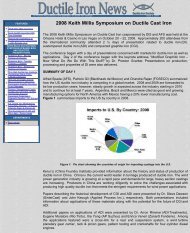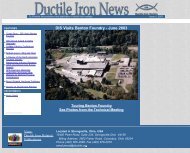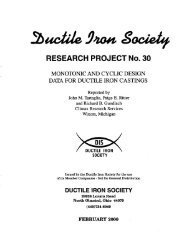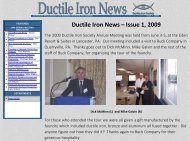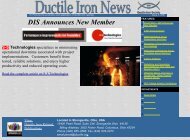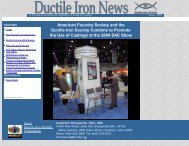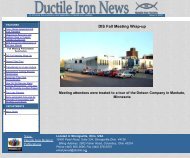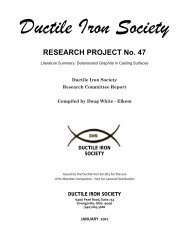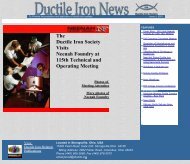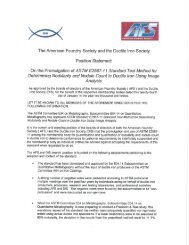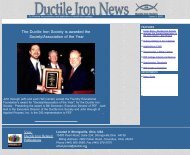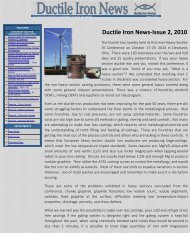Create successful ePaper yourself
Turn your PDF publications into a flip-book with our unique Google optimized e-Paper software.
Phase Changes Occurring During Heating of Cast <strong>Iron</strong>s<br />
It is of interest to summarize the major phase changes that take place during the heating of cast irons in fusion welding. Initially the cast iron<br />
microstructure consists of the excess carbon phases (graphite and carbide), the matrix (ferrite and/or pearlite), and the intercellular structure. No<br />
significant changes typically occur on heating until austenite starts to form (changes in pearlite lamellae are minor). Pearlite and the intercellular<br />
structure will transform to austenite first (compositions near eutectoid), with ferrite transforming later (with carbon diffusion from graphite).<br />
Homogeneity of the austenite depends upon time and temperature, although diffusion rates for carbon are appreciably greater than for alloying<br />
elements (e.g., Si, Mn, Ni, Cr, Mo, etc.).<br />
The ability of the matrix to withstand stresses introduced during the non-uniform heating of cast irons is a function of the matrix microstructure.<br />
Ferritic matrices provide the greatest opportunity for dimensional adjustment (yielding). Finer pearlite lamellae will be more prone to crack initiation,<br />
as will intercellular regions which typically contain carbides.<br />
Melting starts to take place where the local composition has the lowest melting point (near eutectic composition). Since the local carbon content is a<br />
critical factor in this regard, the first areas to melt are observed at the graphite austenite interface and in the intercellular regions (where there is a<br />
lower melting point due to carbon and alloying element concentrations). Carbon is more accessible from the edges of the graphite basal planes so<br />
that melting starts at the tips of flake graphite, at the graphite spheroid-austenite interface, at the temper carbon-austenite interface, etc. The<br />
process of melting develops over a temperature range so that a zone of partial fusion can be expected outside of the resultant fusion zone.<br />
Within the fusion zone convection insures homogeneity of melt composition. However, a thin region at the edge of the fusion zone remains<br />
unmixed. The composition of the fusion zone is, of course a function of the amount of dilution due to different metal compositions or filler metals.<br />
Phase Changes Occurring During Cooling of Cast <strong>Iron</strong>s<br />
On cooling, the most rapid cooling rates are in the fusion zone, with cooling rates decreasing as distance from the fusion zone increases. Cast iron<br />
microstructures are highly sensitive to cooling rate variations, both during solidification and solid state transformation. Sensitivity of the fusion zone<br />
to cooling rates depends upon the composition of the melt in the fusion zone. If it is a typical cast iron composition, solidification will favor carbide<br />
and under cooled graphite formation. If sufficiently alloyed, say with nickel, these undesirable morphologies will be minimized or eliminated.<br />
However, the liquid which formed in the zone of partial fusion remains highly susceptible to solidification as eutectic carbide. If the liquid in the<br />
partial fusion zone is interconnected, a region of brittle eutectic carbide will be present to serve as a path for crack formation. The ability to limit the<br />
interconnection within the partial fusion zone depends upon the initial microstructure of the cast iron and the welding procedures used.<br />
When permitted to cool at a sufficient rate into or through the Ms-Mf temperature range martensite formation will occur. To avoid martensite<br />
formation it is necessary to cool sufficiently slowly through this temperature range (essentially from red to black as the casting cools).<br />
Typical Modifications of Procedures for the Welding of Cast <strong>Iron</strong>s<br />
As noted earlier, the fusion welding of cast irons is usually compared to procedures used in the welding of structural steels, with modifications of<br />
those procedures to accommodate the metallurgical characteristics of cast irons. The more significant of these procedure modifications will be<br />
discussed.<br />
Avoidance of Martensite Formation. The presence of silicon, and of the possible saturation of carbon in austenite by drawing carbon from the<br />
graphite phase, greatly increases the effective hardenability of the austenite matrix – both martensitic and pearlitic hardenability. The propensity for<br />
cracking therefore requires that cooling through the Ms-Mf temperature range be sufficiently slow that martensite formation will not occur. This is<br />
accomplished by pre-heating the casting, or the region of the casting to be welded to a temperature of at least 500F, maintaining that temperature<br />
throughout welding followed by slow cooling to room temperature.<br />
Minimizing the Partial Fusion Zone. Because the eutectic of cast irons solidifies (and melts) over a range of temperatures a zone of partial fusion<br />
outside of the weld fusion zone cannot be prevented from forming. Cooling rates within this region are sufficient for the melt in this region to solidify<br />
as a carbidic eutectic. One must minimize the extent of this partial fusion zone in order to prevent the development of a cracking path just outside<br />
of the fusion zone. This requires that a sufficiently steep thermal gradient be maintained throughout welding, thereby minimizing the thickness of the<br />
partial zone and the interconnection of eutectic melt.<br />
The geometry of this partial fusion zone is also a function of the graphite morphology, since the partial fusion zone develops as a result of eutectic<br />
liquid formed as a diffusion couple between graphite and austenite forming preferentially where the carbon basal planes are exposed, around the<br />
circumference of spheroidal graphite, in certain regions of compacted graphite, a the ends of flake graphite, throughout temper carbon nodules, etc.<br />
Avoiding Carbide Formation in the Fusion Zone. The highest cooling rates in fusion welding are encountered within the fusion zone. If the<br />
composition of the fusion zone is typical of a cast iron the fusion zone will solidify with a predominance of carbidic eutectic. To avoid this one must<br />
either alter the melt composition of the fusion zone or develop a fusion zone melt composition that has sufficient graphitizing potential to avoid<br />
carbide formation. In the first case this is readily accomplished by using a nickel bearing filler metal so that sufficient nickel dilutes the base metal in<br />
the fusion zone preventing eutectic carbides . In the second case a technique must be employed that provides the required graphitizing potential.<br />
One procedure that has been developed for the welding of cast irons, particularly ductile irons, is an oxyacetylene welding procedure that was<br />
patented in 1967 , but which is generally unknown today to casting producers or designers. This fusion welding procedure is being used to produce<br />
metallurgically satisfactory welds over the range of mechanical property requirements of engineering grade ductile iron castings.<br />
Summary of the Welding Procedure<br />
This fusion welding procedure consists of the following steps:



